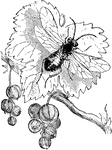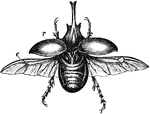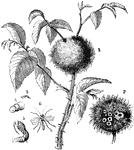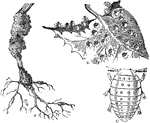
Pollination of an Orchid
Also known as Orchis morio. A depiction of the pollination of an orchid, where a hive bee is sucking…
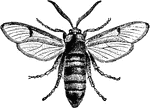
Hornet Moth
Also known as Sesia apiformis. A large moth with a striking imitation of a hornet. They are, however,…
!["The larvae of [Saperda populena] live in gall-like swellings in the branches [of poplar]."—Nicholson, 1884](https://etc.usf.edu/clipart/79000/79089/79089_populena_mth.gif)
Saperda Populena
"The larvae of [Saperda populena] live in gall-like swellings in the branches [of poplar]."—Nicholson,…

Click Beetle
Also known as skipjacks. They are a beetle characterized by a click mechanism they possess, which they…
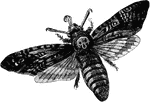
Death's-Head Hawkmoth
This insect is easily identified by the vaguely human skull-shaped pattern of markings on the thorax.

Potato Beetle
Also known as Doryphora decemlineata. It is approximately 10 millimeters in length, with a bright yellow…
!["The [potato beetle larva] is pale yellow, or, rather, dusky-yellow, or freckled with minute black dots on the back; and there are two rows of larger black dots along each side; the legs are black."—Nicholson, 1884](https://etc.usf.edu/clipart/79000/79099/79099_potatolarva_mth.gif)
Larva of Potato Beetle
"The [potato beetle larva] is pale yellow, or, rather, dusky-yellow, or freckled with minute black dots…

Large White Cabbage Butterfly
Also known as Pieris brassicae. It is commonly found throughout Europe, Asia, and north Africa. The…

Larva and Pupa of a Large White Cabbage Butterfly
Also known as Pieris brassicae. An image of the larva and pupa of the large white cabbage butterfly.
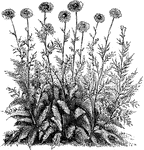
Pyrethrum Roseum Flore-Pleno
A plant with solitary pink flowers, with yellow disks. They generally reach up to 2 feet in height,…

Larvae of Rose Sawfly
A parasite which feeds as larvae in rose-twigs or upon the leaves. Some species are confined to roses…

Buffalo Tree-Hopper
"The Buffalo Tree-Hopper and its work: a, Adult; b, Fresh egg slits; c, Eggs in slits, natural size;…
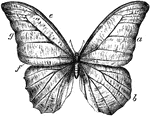
Butterfly
"Shows a butterfly with comparatively very large wings. The nervures are seen to be a great advantage…
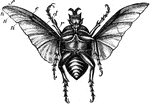
Large Beetle
"Under surface of large beetle, with deeply concave and comparatively small wings, shows that the nervures…
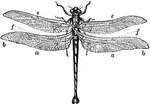
Dragonfly
An insect characterized by large multifaceted eyes, two pairs of strong transparent wings, and an elongated…

Devil's Coach Horse
This insect can be beneficial to gardens. This insect eats other insects and snails.
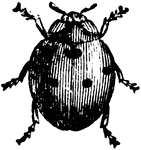
Seven-Spotted Ladybird
The seven-spotted lady bird is beneficial to gardens because it eats aphides.

Grub of Ladybird
The grub of the beneficial ladybird. This insect is beneficial to gardens because it eats aphides.

Larva, Frothy Secretion, and Perfect Insect of the Frog Hopper
Frog hopper belong to the same order as aphidoe, to the section which has the leathery upper wings.…
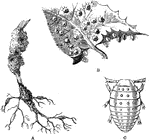
Grape or Vine Louse
The grape or vine louse belongs to the Aphides, or Green Flies. The insect lives on the European vine.…
Larva of a Small Cabbage Butterfly
Generally, larva of the butterfly resembles a worm. Larva do not resemble the mature insect.
Larva of a Leopard Moth
Larva are unlike the mature insect. Larva of the moth or butterfly resemble worms. It may have a distinct…
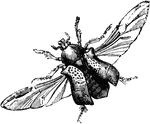
Rose Chafer with Hind Wings Extended
The body of the rose chafer is encased with a hard crust. The front wings are modified to form hard…

Larva of the Colorado Beetle
The larva of the colorado beetle is very unlike the adult insect. The larva is harmful to gardens.
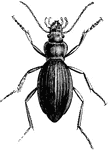
Common Ground Beetle
The common ground beetle feeds mostly on insects, though some of them are partly vegetarian.

Devil's Coach Horse
The Devil's Coach Horse is also known as Rove Beetles. These beetles feed largely on decaying matter.

House Cricket
House crickets are in the order Orthoptera. Crickets are destructive to plants in every stage after…

Green Grasshopper
Grasshoppers belong to the order Orthoptera. Grasshoppers have mouths fit for biting, net-veined wings,…

Female Cockroach
Cockroaches belong to the order Orthoptera. Cockroaches are harmful to plants in every stage after leaving…
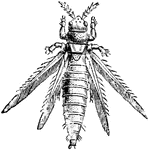
Magnified Thrips
Thrips are very small insects that live in flowers. Thrips gnaw the surface of petals.
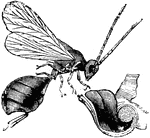
Oak Gall Fly
This picture shows the hinder rings of the abdomen and the ovipositor. The ovipositor serves to pierce…

Large White Cabbage Butterfly
Large white cabbage butterflies have large wings that are covered with small scales. The mouth is not…

Female Gipsy Moth
Female gipsy moths have large wings that are covered with small scales. The mouth is not able to bite.…

Large Cabbage Butterfly Caterpillar
Caterpillar, larvae of the butterfly, are harmful to plants. These caterpillars sucker feet on the hinder…

Codlin Moth and Grub
Caterpillar, larvae of the moth and butterfly, are harmful to plants. These caterpillars sucker feet…
Bean Aphis
Bean aphis have membranous and naked wings with few supporting nervures. Some species are wingless.

Larva, Frothy Section, and Perfect Insect of the Frog Hopper
Frog hoppers belong to the order Heteroptera. This order is also known as plant bugs. These insects…
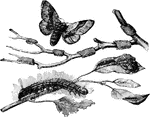
Lackey Moth
Bombyx Neustria, or the lackey moth, lay their eggs on the twigs of various trees. When the larvae emerge…

Grub of a Seven Spotted Ladybug
Ladybugs are a type of small beetle. The larvae feed on aphides, making them beneficial to horticulturalists.
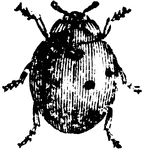
Seven Spotted Ladybug
The seven spotted ladybug is one of the most common species of ladybug. The ladybug is also known as…
Eggs, Larvae, and Perfect Insect of the Lily Beetle
The larvae of the lily beetle live on lilies, devouring their leaves. The antennae are on the front…

Larvae and Web of Lyda Pyri
Lyda is a genus of sawflies. Lyda pyri injure plums and other stone fruit trees. The habits of the larvae…
Millipede
Millipedes are usually cylindrical. The origins of the legs are usually brought very close to the middle…
Mole Cricket
The mole cricket has a smoky brown color above and a yellowish red below. The cricket has a velvety…

Humming Bird Hawk Moth
The humming bird hawk moth has long, narrow front wings. The front wings move rapidly causing the moth…
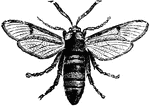
Clear Wing Moth
When clear wing moths are larvae they live in burrows, in the roots and stems of many plants, and often…

Potherb Moth
The hind wings of the potherb moth are frequently unspotted. The body is thick and heavy. The color…

Nut Weevil and Grub
Nut weevil is the common name of balaninus nucum. The weevil is one third of an inch long with an egg…

Oak Galls
Galls are structures budded out from stems, leaves, or other pats of plants. Galls are made by insects…
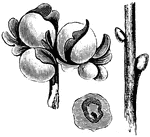
Oak Galls
Galls are structures budded out from stems, leaves, or other pats of plants. Galls are made by insects…

Larvae of Onion Fly
Pictured is a section of an onion attacked by the larvae of the onion fly. The burrow of the larva is…
